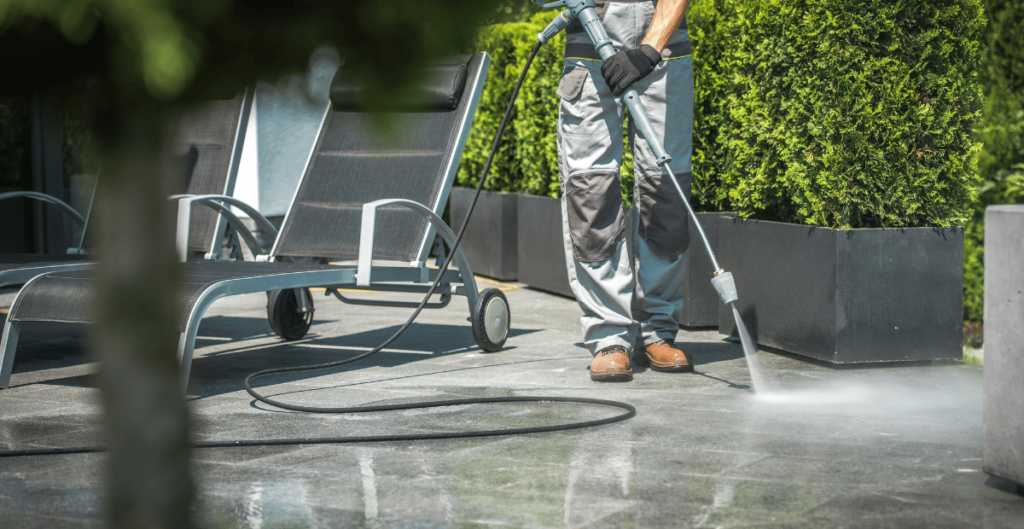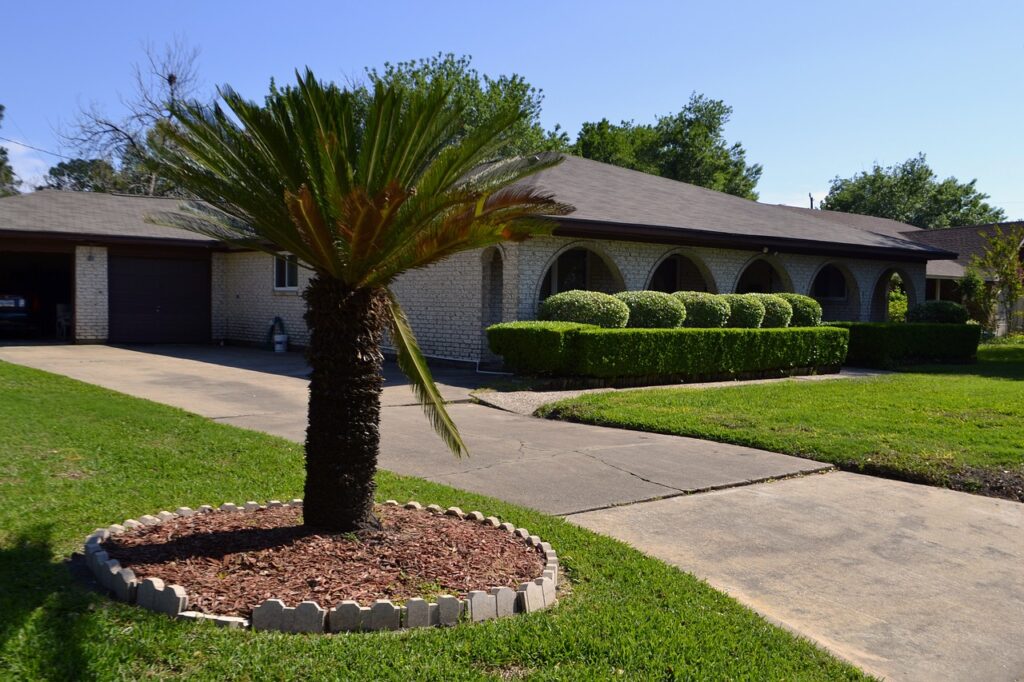Concrete is a versatile and durable building material that is used in a variety of areas throughout homes and driveways. Some common areas where concrete is used are driveways. Driveways are a popular choice due to their durability and ability to withstand heavy loads. Concrete patios are another popular choice for outdoor living spaces.
They can be used for entertaining, cooking, and relaxing. Concrete walkways are a functional and attractive option for connecting different areas of a property. They can be used to create a path through a garden or to connect a driveway to a front door. Many basements are made of concrete and can be used as additional living space or storage area.
Concrete is a durable and long-lasting material, but it can still be affected by various types of stains over time. Here are some common types of stains that concrete can get, starting with the simplest to the most complex:
- Organic stains
- Efflorescence
- Oil and grease stains
- Rust stains
- Mold and mildew stains
- Dye and Paint stains
Stains on concrete can be removed, but the method and frequency of cleaning will depend on the type of stain and the condition of the concrete It’s important to remove stains as soon as they appear to prevent them from becoming ingrained in the concrete and more difficult to remove. Also, keep in mind that some stains may require specialized cleaning products or professional help, and it’s always recommended to test a small, inconspicuous area before applying any cleaning solution to the entire surface.
Equipment That Can Be Used While Cleaning Concrete
- Power washer
- Wire Brush
- Degreaser
- Acid-Based Concrete Cleaner
- Scrub brush
- Pressure-mounted broom
- Garden hose
- Protective gear
How To Remove Stains of Organic from Concrete?
Organic stains on concrete can come from a variety of sources, such as leaves, dirt, and other organic materials. These stains can be unsightly and can detract from the overall appearance of the concrete surface. Fortunately, organic stains can be removed with the right cleaning methods and equipment.
Power washing:
One of the most effective ways to remove organic stains from concrete is by using a power washer. This powerful tool uses high-pressure water to blast away dirt and grime, making it an ideal tool for removing stains caused by organic materials.
Detergent solution:
A mild detergent solution can also be used to remove organic stains from concrete. Mixing a small amount of mild detergent with warm water can create a cleaning solution that can be used to scrub away dirt and grime.
Efflorescence
It is a common issue that affects concrete surfaces. It is a white or gray powdery substance that forms on the surface of concrete and can be unsightly and difficult to remove. This phenomenon occurs when water containing dissolved salts and minerals comes into contact with concrete, and the water evaporates, leaving behind the salts and minerals on the surface.
There are several methods available for removing efflorescence from concrete surfaces, each with its own pros and cons.
Scrubbing with a mixture of water and muriatic acid:
Scrubbing with a mixture of water and muriatic acid is a method commonly used to remove efflorescence from concrete surfaces. Muriatic acid is a type of hydrochloric acid that is commonly used in the construction industry and can be effective at breaking down and dissolving the salts and minerals that makeup efflorescence.
To use this method, a solution of water and muriatic acid is mixed together, usually in a ratio of 1 part acid to 10 parts water. The solution is then applied to the surface of the concrete using a stiff-bristled brush, and the surface is scrubbed thoroughly. The solution should be left on the surface for a few minutes to allow the acid to break down the efflorescence, and then the surface should be rinsed thoroughly with water.
This method is effective at removing even stubborn efflorescence, but it can be labor-intensive and requires the use of a potentially harmful chemical. That’s why it is important to use the appropriate safety precautions when using this method. Always wear gloves, goggles, and appropriate clothing while working with any chemical solutions. Avoid skin and eye contact and always keep the chemical solutions out of reach of children and pets.
Pressure washing:
This method is effective at removing efflorescence and can be done relatively quickly, but it can also damage the concrete surface if not done properly you may need to hire a professional for this job which can be costly but if you decide to do it by yourself then it is important to wear appropriate personal protective equipment, such as goggles and ear protection, to avoid any accidents.
This method uses high-pressure water to blast away the efflorescence to use this method, a pressure washer is used to spray water at high pressure onto the surface of the concrete. The pressure washer nozzle should be held at a distance of around 12 inches to 18 inches away from the surface and moved in a back-and-forth motion. The efflorescence should start to break down and lift off the surface as the pressure washer is moved over it.
Chemical cleaners:
Chemical cleaners are specialized products that are specifically formulated to remove efflorescence from concrete surfaces. These cleaners can be effective at removing the efflorescence, but they can also be expensive and may not be as effective as other methods.
Here are a few examples of commonly used chemical cleaners:
Both power washing and detergent solution are effective in removing organic stains from concrete. Power washing can also remove built-up dirt, grime, and other debris that can accumulate over time. A detergent solution is a less harsh and less expensive option to remove organic stains. Power washing can be a labor-intensive process and requires the use of specialized equipment and the solution may not be as effective as power washing in removing heavy stains. Both methods may require multiple applications to completely remove the stain.
TSP (Tri-Sodium Phosphate):
TSP is a powerful cleaner that is effective at removing efflorescence, as well as other types of stains and grime.TSP can be corrosive and can damage surfaces if not used properly. TSP is also toxic and can be harmful to humans and pets if ingested.
Muriatic acid:
Muriatic acid is a strong acid that is effective at dissolving efflorescence and other types of stains. This acid is a corrosive chemical that can cause burns and damage surfaces if not used properly. It also produces toxic fumes and requires proper ventilation.
Concrete Efflorescence remover:
These products are specifically formulated to remove efflorescence and can be effective at breaking down and dissolving the salts and minerals that makeup efflorescence.
chemical cleaners can be effective at removing efflorescence from concrete surfaces, but they can also be expensive and potentially harmful if not used properly. It is essential to follow the manufacturer’s instructions and safety precautions and to use appropriate protective gear while working with these chemicals. It is always a good idea to test a small area before applying it to the whole surface to ensure the chemical cleaner will not damage the surface.
Removing Oil and Grease Stains from Concrete:
There are several methods available for removing oil and grease stains from concrete surfaces. One method is to use a degreaser, which is a specialized product specifically formulated to remove oil and grease stains from concrete surfaces. These products can break down and dissolve the oil and grease, making them easy to remove.
However, these products can be expensive. Another method is using hot water and detergent, which can be effective at removing oil stains from concrete surfaces. It is relatively inexpensive and easy to use, but this method can be time-consuming and requires a lot of elbow grease.
Removing Rust stains from Concrete:
Rust stains are a common issue that affects concrete surfaces and can be unsightly and difficult to remove. The most effective method for removing rust stains from concrete depends on the severity of the stains and the type of surface.
Using a rust remover:
There are specialized rust removers available that are specifically formulated to remove rust stains from concrete surfaces. These products can break down and dissolve rust, making them easy to remove. These products can be effective but some of them are corrosive and can damage surfaces if not used properly.
Scrubbing with a mixture of water and muriatic acid:
This method is similar to the method used to remove efflorescence. A solution of water and muriatic acid is mixed together, usually in a ratio of 1 part acid to 10 parts water. The solution is then applied to the surface of the concrete using a stiff-bristled brush, and the surface is scrubbed thoroughly. The solution should be left on the surface for a few minutes to allow the acid to break down the rust, and then the surface should be rinsed thoroughly with water.
Scrubbing with a mixture of water and lemon juice:
Lemon juice is acidic and can help to dissolve rust stains. Mix equal parts of water and lemon juice and apply it to the rust stain, let it sit for 15 minutes, and then scrub the area with a stiff-bristled brush. Rinse the surface with water and repeat if necessary.
Using a poultice:
A poultice is a paste-like mixture made of a cleaning agent and an absorbent material. The paste is applied to the rust stain and covered with plastic wrap. The poultice is left to sit on the rust stain for several hours, or even overnight, and then removed and the surface is cleaned with water.
Removing Mold and mildew stains
Mold and mildew stains can be unsightly and potentially harmful to your health, so it’s important to remove them from concrete surfaces as soon as possible. The best method for removing mold and mildew stains from concrete will depend on the severity of the stains and the condition of the concrete.
Clean the area with a mixture of water and white vinegar. Mix 1 cup of white vinegar with 1 gallon of water and use a stiff-bristled brush to scrub the stained area. Rinse the area thoroughly with water and allow it to dry completely.
Use a commercial mold and mildew cleaner. These can be found at most home improvement stores and are specifically designed to remove mold and mildew stains. Be sure to follow the manufacturer’s instructions and use the product in a well-ventilated area.
Apply a solution of bleach and water. Mix 1 cup of bleach with 1 gallon of water and use a stiff-bristled brush to scrub the stained area. Be sure to wear gloves and eye protection, as bleach can be harsh on the skin and eyes. Rinse the area thoroughly with water and allow it to dry completely.
If the above methods do not work, you may need to consider using a pressure washer to remove the stains but be careful as high-pressure water can damage the concrete if not used properly.
If the mold and mildew stains are particularly stubborn and none of the above methods work, you may need to consider hiring a professional to remove the stains.
Removing Dye and Paint stains
Removing Dye and Paint stains from concrete can be a challenging task, especially when the stains are large. However, with the right methods and cleaning steps, it is possible to remove even the most stubborn stains.
Method for Removing Large Dye Stains:
Identify the type of dye: The first step in removing a large dye stain is to identify the type of dye that caused the stain. This will determine the type of cleaning solution that should be used.
Use a pressure washer: A pressure washer is an effective tool for removing large dye stains from concrete. Use the pressure washer to blast the stain with water, being careful not to damage the surrounding concrete.
Apply a cleaning solution: After using the pressure washer, apply a cleaning solution that is suitable for the type of dye that caused the stain. A solution of water and oxalic acid is effective for removing most dye stains.
Scrub the stain: Using a stiff-bristled brush, scrub the stain vigorously. This will help to loosen the dye molecules and make them easier to remove.
Rinse the area: After scrubbing the stain, rinse the area with water. This will remove the cleaning solution and any remaining dye.
Method for Removing Large Paint Stains:
Identify the type of paint: The first step in removing a large paint stain is to identify the type of paint that caused the stain. This will determine the type of cleaning solution that should be used.
Use a paint scraper: A paint scraper can be used to remove large paint stains from concrete. Use the paint scraper to scrape away as much of the paint as possible, being careful not to damage the surrounding concrete.
Apply a cleaning solution: After using the paint scraper, apply a cleaning solution that is suitable for the type of paint that caused the stain. A solution of water and muriatic acid is effective for removing most paint stains.
Scrub the stain: Using a stiff-bristled brush, scrub the stain vigorously. This will help to loosen the paint molecules and make them easier to remove.
Rinse the area: After scrubbing the stain, rinse the area with water. This will remove the cleaning solution and any remaining paint.
Conclusion – Remove Stains From Concrete
In Short, there are several methods for removing stains from concrete, including using a pressure washer, a concrete cleaner, a degreaser, or a mixture of baking soda and water. It is important to test a small area before applying any cleaning solution to the entire surface to ensure that it does not cause damage. Safety precautions include wearing gloves and eye protection, and ensuring proper ventilation when using chemical cleaners.
Additionally, it is important to avoid using acidic cleaners on colored or stained concrete, as they can cause discoloration. It is also recommended to rinse the surface thoroughly after cleaning to remove any residue. get Concrete Service At Affordable Price In Northern Colorado. For More Information Contact Us



